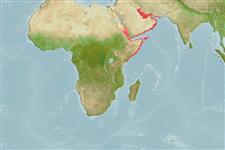Common names from other countries
Teleostei (teleosts) >
Tetraodontiformes (Puffers and filefishes) >
Monacanthidae (Filefishes)
Etymology: Stephanolepis: Greek, stephanos = crown + Greek, lepis = scale (Ref. 45335).
Environment: milieu / climate zone / depth range / distribution range
Ecology
Marine; demersal; depth range 20 - 50 m (Ref. 28016). Tropical; 30°N - 2°S, 32°E - 62°E
Western Indian Ocean: Persian Gulf (Ref. 3467) to the Red Sea and immigrated via the Suez Canal to the Mediterranean Sea (Ref. 11441).
Size / Weight / Age
Maturity: Lm ? range ? - ? cm
Max length : 25.0 cm TL male/unsexed; (Ref. 30573)
Lives in coastal rocky substrate, usually with vegetation. Consumes small invertebrates plucked from rocks (Ref. 52629). One of the earlier Lessepsian immigrants actually well
established in the eastern part of the Mediterranean Sea and it inhabits various substrates and is usually encountered on rocky bottoms with vegetation, sandy and muddy bottoms as well as seagrass meadows (Ref. 104758).
Life cycle and mating behavior
Maturities | Reproduction | Spawnings | Egg(s) | Fecundities | Larvae
Hutchins, J.B., 1984. Monacanthidae. In W. Fischer and G. Bianchi (eds.) FAO species identification sheets for fishery purposes. Western Indian Ocean (Fishing Area 51). Vol. 3. FAO, Rome. pag. var. (Ref. 3467)
IUCN Red List Status (Ref. 130435)
CITES (Ref. 128078)
Not Evaluated
Threat to humans
Harmless
Human uses
Fisheries: minor commercial
Tools
Special reports
Download XML
Internet sources
Estimates based on models
Preferred temperature (Ref.
115969): 23.5 - 29.2, mean 26.1 (based on 42 cells).
Phylogenetic diversity index (Ref.
82804): PD
50 = 0.5312 [Uniqueness, from 0.5 = low to 2.0 = high].
Bayesian length-weight: a=0.01738 (0.01425 - 0.02120), b=2.92 (2.86 - 2.98), in cm Total Length, based on LWR estimates for this species (Ref.
93245).
Trophic level (Ref.
69278): 4.6 ±0.09 se; based on food items.
Resilience (Ref.
120179): Medium, minimum population doubling time 1.4 - 4.4 years (Preliminary K or Fecundity.).
Fishing Vulnerability (Ref.
59153): Low vulnerability (15 of 100).
